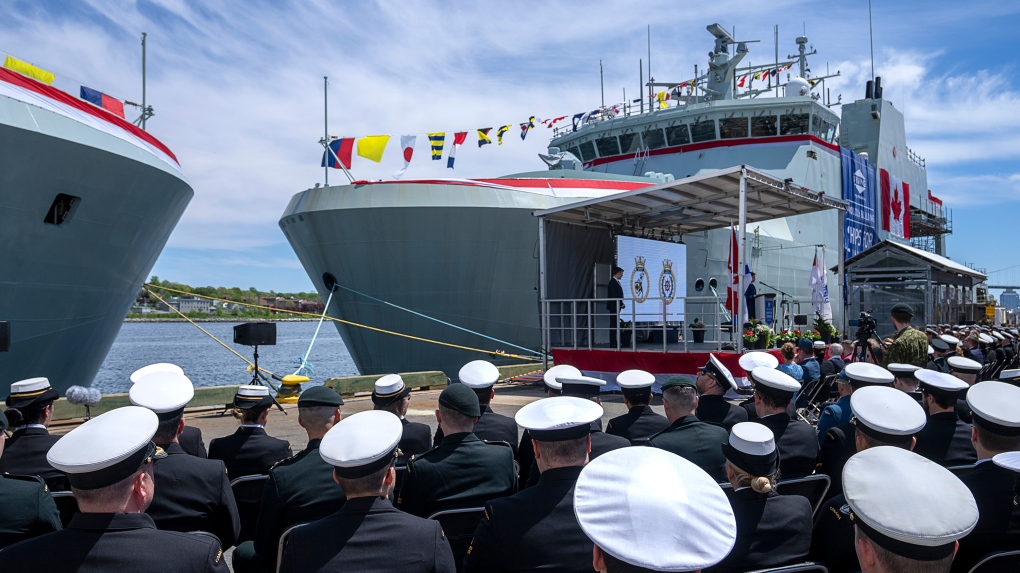Canadian navy's Pacific fleet to accept first Arctic patrol vessel
 Members of the Royal Canadian Navy attend a naming ceremony for HMCS Margaret Brooke and HMCS Max Bernays, Arctic and Offshore Patrol Ships (AOPS) at Halifax Shipyards in Halifax on Sunday, May 29, 2022. THE CANADIAN PRESS/Andrew Vaughan
Members of the Royal Canadian Navy attend a naming ceremony for HMCS Margaret Brooke and HMCS Max Bernays, Arctic and Offshore Patrol Ships (AOPS) at Halifax Shipyards in Halifax on Sunday, May 29, 2022. THE CANADIAN PRESS/Andrew Vaughan
The Canadian navy's Pacific fleet is set to take possession of its first Arctic patrol vessel, which arrives in British Columbia next week ahead of a formal commissioning ceremony.
HMCS Max Bernays is the third Arctic patrol ship built for the Royal Canadian Navy, which has ordered six of the vessels to conduct surveillance and assert sovereignty over territorial waters, including in the Far North.
The ship, which left Halifax last month and transited the Panama Canal before making port visits in California, is scheduled to arrive at its home port in Esquimalt, B.C., on Monday.
Following a commissioning ceremony in North Vancouver on May 3, the new vessel will immediately undergo maintenance work, according to the Department of National Defence, which expects the vessel to be ready to participate in the biannual Exercise Rim of the Pacific (RIMPAC), the world's largest multinational naval exercise, off Hawaii this summer.
Ships not ready for helicopter operations
While the Arctic patrol vessels were designed to accommodate the CH-148 Cyclone, the military's main maritime helicopter, that capability likely won't be realized for years to come.
National Defence spokesperson Kened Sadiku said plans are underway to "support and deliver initial air operations capabilities during the RIMPAC exercise this summer," however the military could not confirm whether that would involve an embarked Cyclone, a different aircraft, or neither.
"The Canadian Armed Forces won't be commenting on any personnel or assets committed to RIMPAC 24 ahead of the official announcement of the exercise, which is expected to come sometime later this spring," he added.
The spokesperson said the military is working to integrate the Arctic patrol vessels with the maritime helicopters by 2027 or 2028. "The capability to fully operate a CH-148 Cyclone Helicopter will be achieved in phased delivery timelines," Sadiku added.
In a separate email on Friday, National Defence spokesperson Andrée-Anne Poulin said that while the new Arctic patrol vessels were "generally configured to operate with a helicopter, they are not yet ready to do so permanently."
The vessels will require several installations and modifications "before the ship would be considered compliant for air operations" with the Cyclone or lighter aircraft, according to Poulin. "No specific dates can be provided at this time," she added.
Following the RIMPAC exercise, the Pacific fleet's newest ship is expected to patrol the western High Arctic during Operation Nanook, the Canadian Armed Forces' primary northern exercise, in the fall.
CTVNews.ca Top Stories

Air Canada walks back new seat selection policy change after backlash
Air Canada has paused a new seat selection fee for travellers booked on the lowest fares just days after implementing it.
Province boots mayor and council in small northern Ont. town out of office
An ongoing municipal strike, court battles and revolt by half of council has prompted the province to oust the mayor and council in Black River-Matheson.
3 law officers serving warrant are killed, 5 wounded in shootout at North Carolina home, police say
Three officers on a U.S. Marshals Task Force serving a warrant for a felon wanted for possessing a firearm were killed and five other officers were wounded in a shootout Monday at a North Carolina home, police said.
'Shocked and concerned': Calgary principal charged with possession of child pornography
A Calgary elementary school principal has been charged with possession of child pornography, authorities announced Monday.
Health authority confirms cockroaches at B.C. hospital, insists they 'do not bite'
The Vancouver Island Health Authority is downplaying what staff describe as a cockroach infestation in a medical unit of Saanich Peninsula Hospital.
Toronto police arrest 12 people, lay 102 charges in major credit card fraud scheme
Toronto police say 12 people are facing a combined 102 charges in connection with an investigation into a major credit fraud scheme.
Winner of US$1.3 billion Powerball jackpot is an immigrant from Laos who has cancer
One of the winners of a historic US$1.3 billion Powerball jackpot last month is an immigrant from Laos who has had cancer for eight years and had his latest chemotherapy treatment last week.
Britney and Jamie Spears settlement avoids long, potentially ugly and revealing trial
Britney Spears and her father Jamie Spears will avoid what could have been a long, ugly and revealing trial with a settlement of the lingering issues in the court conservatorship that controlled her life and financial decisions for nearly 14 years.
WATCH 'Double whammy': What happens if you don't file your taxes by the deadline
The clock is ticking ahead of the deadline to file a 2023 income tax return. A personal finance expert explains why you should get them done -- even if you owe more than you can pay.
































